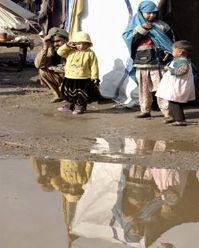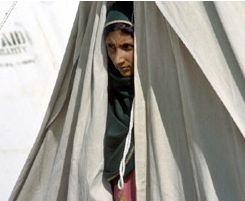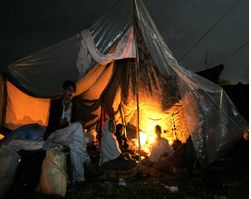Now, the Second Wave
By Syed Talat Hussain | News & Politics | Published 20 years ago
Two months after suffering the unimaginable devastation of the earthquake, the shattered communities of Azad Kashmir and the NWFP continue to careen between hope and despair. Life is uncertain, and normalcy a far cry. And in more ways than one, the grimmest part of the challenge is now at hand. It may be less spectacular than the immediate bloody aftermath of the earthquake, but has the potential to inflict even more damage than the rupture that shook the country on October 8.
Most immediate is the mind-boggling task of managing displaced communities whose worst fears — winter rains and snowfall — are now at hand. To galvanise the international community, the official pitch at the Donors Conference focused on rehabilitation and reconstruction, and not on relief. Some UN sources maintain that the idea of keeping the focus on post-rescue rebuilding of infrastructure, while understandable, has a fundamental flaw: it soft-peddles the crucial phase that the crisis has already entered, where communities have to be housed and fed, protected against epidemics during the tough winter season that has already set in.
“I have sat in on almost all the meetings on coordination of the relief effort. I have heard more plans about where to build the cities, hospitals, schools, and even spanking new four-star hotels than about camps and the vast number of people whose pockets are empty and bodies vulnerable to infections and disease,” says a top UN official who did not wish to be named.
Reacting to this lopsided approach towards the pressing needs of the victims of the earthquake, the UN put out an uncharacteristically terse press release two weeks ago.
Quoting the Humanitarian Coordinator in Pakistan, Jan Vandemoortele, it almost mocked the lofty talk of reconstruction that echoes around Islamabad’s policy-making echelons these days:
“It is important to start building new hospitals and schools as soon as possible but it’s most urgent to save the lives of thousands of children who could then make use of these schools,” said the press release dated November 25.
The UN assessment is shared across the board by other international agencies and local non-governmental organisations working in different earthquake-struck areas. These assessments say that nearly 200,000 lives are in harm’s way. Thousands of others are likely to be confronted with severe shortage of food and medicines and life-threatening infections that putrid conditions at the camps have already started to produce.
A recent survey of camps in Muzaffarabad and Bagh conducted by an international NGO concerned with health-related issues noted a 25 per cent increase in infections of the lungs and liver and various skin diseases.
 “Children and women are the most vulnerable to these diseases and most of these are related purely to lack of adequate facilities at the camps where, in some cases, women defecate inside the camps and male members of the family clean up in the dead of the night,” says a member of this NGO.
“Children and women are the most vulnerable to these diseases and most of these are related purely to lack of adequate facilities at the camps where, in some cases, women defecate inside the camps and male members of the family clean up in the dead of the night,” says a member of this NGO.
“The absence of a simple thing such as a soak-pit near a camp can become the origin of an epidemic killing hundreds. Yet in most camps, that exist in small clusters, little thought has been given to such issues,” says the official.
The threat of disease combined with inadequate food supplies has created an explosive mix: over 1.3 million people who lack proper nourishment and are highly susceptible to illness.
“We cannot say that a large number face imminent death but food insecurity over a long period of time can aggravate threats to human life from weather and wounds, and if allowed to persist, can be a cause of death on its own,” says an official of the World Food Programme.
The deadliest element in this unfolding tragedy happens to be the weather. Up on the mountains and the adjoining areas of the Jhelum and Neelam valleys, a thick crust of white has fallen from the merciless skies. In high altitude areas of the Hazara division, the temperatures have started to plummet. In the normal course of the season, this is nothing new: life is nasty and brutish in the winters. But this time round, inadequate shelter and uncertain food supplies threaten lives as never before.
“Many of the most vulnerable areas were accessible only for a short period of time. That window of opportunity to address their needs has now closed. New landslides are making tricky makeshift roads unsafe for travel. Rocks are slippery and crevices in the mountains, having absorbed fresh moisture and water, are a sure recipe for further evasion. Whatever we have done in these areas, by way of pre-positioning food supplies and other necessities of life, will now be tested. Supplementing these supplies is now very difficult,” says a colonel of the Pakistan Army in Balakot.
This is an honest admission, rare in propagandist times. But the same official was less open to agreeing with the suggestion that pre-positioned supplies, whether of tents or medicines, are less than half of the actual needs of the local population.
“We have distributed whatever we got and we are now arranging supplies for those coming to us for more tents. Food and medicines are being sent to forward bases to meet their needs. I do not think that we are so badly placed as reports in the media suggest.”
 Most aid workers disagree. Last month, at the UN club in Islamabad at a small gathering of foreign NGOs, representatives were unanimous in saying that without swift purchases of additional cereals, and even swifter distribution, the current supplies would probably run out mid-winter.
Most aid workers disagree. Last month, at the UN club in Islamabad at a small gathering of foreign NGOs, representatives were unanimous in saying that without swift purchases of additional cereals, and even swifter distribution, the current supplies would probably run out mid-winter.
Their assessment of the nature of available shelter does not inspire much confidence about the immediate future security of thousands trapped in broken lands, blocked by treacherous landslides and thickening layers of snow.
Says a UN official, “If you go by paper statistics of the tents distributed in these areas, around 70 per cent of the need seems to have been met. But not every tent affords shelter against freezing temperatures. On that international yardstick of what shelter ought to be, we fear that the vast majority of these people are inadequately protected.”
In Mootan Vali, a village of Union Council Bhedi, barely two kilometres from Khawaja Bandi in the Uri Sector of the Line of Control, a crowd of 300 clapping in gratitude for the army’s good work, was stunned into silence when this reporter asked them a simple question: “How many of you have the kind of shelter that will protect you against the coming winter?” Only 20 odd hands went up. The local military commander was quick to grab the mike to explain to the dampened group that more tents were on their way.
The story of lack of proper supplies is repeated village after village. In Rahimkot, a village almost equidistant from Bagh and Chikar in Azad Jammu and Kashmir, dozens of locals have small chits handy to show to any visitor who may be interested. These pieces of paper are need-assessment certificates which the army officials gave to them for obtaining food or tents, or both. Some of these are as much as as a month old. “This is a worthless piece of paper that I am carrying because I have not been able to get anything. I have been to the supply camps several times and each time I am fobbed off with the promise of delivery tomorrow. That day never comes,” says Miraj Mateen, a local shopkeeper.
 Snowfall and a falling mercury have added to these fears and frustrations. In Garhi Habibullah, at an army-run camp of about 600 families, tent-dwellers are growing more restive by the day. Their main concerns are inadequate shelter that is proving to be a poor shield against biting cold and a two-meals-a day food policy that leaves them and their children hungry.
Snowfall and a falling mercury have added to these fears and frustrations. In Garhi Habibullah, at an army-run camp of about 600 families, tent-dwellers are growing more restive by the day. Their main concerns are inadequate shelter that is proving to be a poor shield against biting cold and a two-meals-a day food policy that leaves them and their children hungry.
As elsewhere, disease born of dirty water, crowded tents, and cold are taking hold. But the worst has just started to happen. Communities are being forced down from their abode by unbearable cold. As they descend down from the inhospitable valleys of Naran and Kaghan, they add to the pressures on already overstretched camps.
“We know that hundreds of people are heading for safer areas, thanks to bad weather. These newcomers bring with them a fresh set of needs for which little or no policy framework is ready,” says a member of Oxfam, a British NGO working in these areas.
Part of the problem is that not enough groundwork had been done on the possible numbers who would migrate and leave home and hearth in the harsh winter.
“There was a simple assumption that we all worked with: some of them will stay up there and others will come down. When, where, how many were questions that were not debated thoroughly. We had a general idea of the area where this migration would take place, and that is about all,” said a high-ranking UN official.
For now, there are over 150 camps that are officially acknowledged. Many more have sprung up here and there. There is no plan in the works for deliberate expansion of these camps to accommodate the new influx of internally displaced persons. In reality, therefore, the weather-battered, earthquake-stricken people might walk into another wilderness of poor or non-existent facilities.
And that is the situation on the ground; up on the mountains in areas where the locals have decided, for different reasons, to stick it out in their land rather than walk down, conditions are equally threatening. Other than official claims of having distributed around 500,000 tents out of the assessed need of 650,000, there is no data transparently available to counter-check the state of actual delivery. At any rate, everything and anything that can be stretched and spread over a chunk of the ground has been generously categorised as shelter. Much of this ‘shelter’ has been used to protect wood for the fire and fodder for livestock. Without these two elements, human survival in winter conditions becomes a near impossibility. But this has also meant further degradation of the already inadequate and poor quality shelter for families.
“Try to spread one tent over wood, fodder, livestock and family and you would discover how impossible the task is. We have been struggling to do this ever since a tarpaulin sheet was given to us as a tent three weeks ago, but to no avail. Neither my family, nor my wood and livestock are safe any more. I am stuck here without hope,” says Kabir, a local shopkeeper in village Rajpain, 20 kilometers from Muzaffarabad.
The standard response from the government’s spokespersons to these complaints is to blame the media for exaggerating the negative. A more remorseless response is to chide the victims for being too irate and impatient. The state of denial to the second wave of cold death sweeping these areas is best summed up in the general description officialdom gives to all foreign visitors.
They often quote the presence of “encouraging signs.” More people are found visiting the bazaars than graveyards, visitors and foreign media members are told. Markets in the shattered towns have opened up; makeshift homes are being rebuilt to protect the remains of families and livestock; local administration is more visible and the makeshift relief camps observed in the first month of the crisis have given way to a system that is working.
This description sounds all the more compelling when it is combined with the endless drum-beating about the successful international donor conference on October 19, after which the world’s total pledges for reconstruction and rehabilitation went up to 6.1 billion dollars, a little under a billion dollars more than the target President General Pervez Musharraf had set for the event.
But ground reality, as almost always, is different from official reality. UN officials and members of donor agencies agree that winter has arrived long before the aid pledges translate into cash. From the looks of it, the stage is set for another tragedy to unfold. Although this time round, no one will be able to say that there was no warning.
The writer is former executive editor of The News and a senior journalist with Geo TV hosting a prime time current affairs program.


